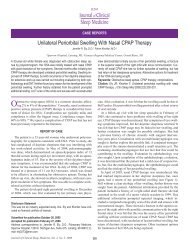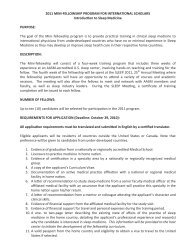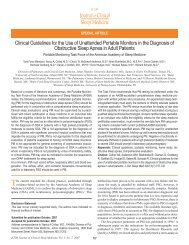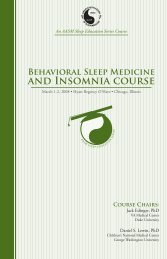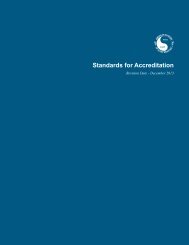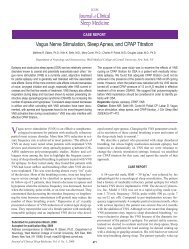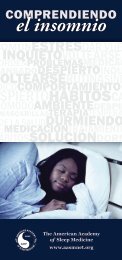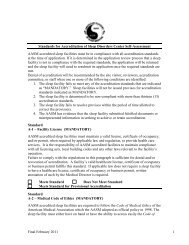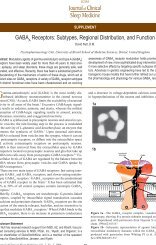Insomnia and Daytime Napping in Older Adults - ResearchGate
Insomnia and Daytime Napping in Older Adults - ResearchGate
Insomnia and Daytime Napping in Older Adults - ResearchGate
Create successful ePaper yourself
Turn your PDF publications into a flip-book with our unique Google optimized e-Paper software.
S Ancoli-Israel <strong>and</strong> JL Mart<strong>in</strong><br />
<strong>Insomnia</strong> <strong>in</strong> the Elderly<br />
PREVALENCE<br />
The prevalence of chronic <strong>in</strong>somnia <strong>in</strong>creases with age. The<br />
1991 National Sleep Foundation survey of 1000 US residents aged<br />
18 years <strong>and</strong> older found the prevalence of chronic <strong>in</strong>somnia <strong>in</strong> the<br />
elderly cohort (age ≥ 65 years) to be 20%, compared with 9% <strong>in</strong><br />
the total survey sample. 18 Although older adults were <strong>in</strong>cluded <strong>in</strong><br />
this survey, they made up a small proportion of respondents, <strong>and</strong><br />
therefore these results may not be very generalizable to all older<br />
adults. However, surveys that focused on the elderly have also<br />
been conducted. Almost a decade earlier, <strong>in</strong> 1982, the National<br />
Institute of Ag<strong>in</strong>g conducted the 3-center Established Populations<br />
for Epidemiologic Studies of the Elderly study to determ<strong>in</strong>e the<br />
prevalence of sleep compla<strong>in</strong>ts among 9828 community-dwell<strong>in</strong>g<br />
elderly persons aged 65 <strong>and</strong> older. 19 Fifty-seven percent of<br />
the participants reported at least 1 chronic sleep compla<strong>in</strong>t, <strong>and</strong><br />
29% reported hav<strong>in</strong>g <strong>in</strong>somnia. In each age cohort, the prevalence<br />
of <strong>in</strong>somnia was significantly higher among women than among<br />
men (25% vs 20%, 31% vs 21%, <strong>and</strong> 36% vs 29%, respectively;<br />
p < .05 for each sex difference). Analysis of 3-year follow-up data<br />
from more than 6800 persons aged 65 years <strong>and</strong> older who were<br />
assessed dur<strong>in</strong>g Established Populations for Epidemiologic Studies<br />
of the Elderly found the annual <strong>in</strong>cidence of chronic <strong>in</strong>somnia<br />
to be approximately 5%. 9 More recently, the 2003 National Sleep<br />
Foundation survey of 1000 older adults found that 47% reported<br />
hav<strong>in</strong>g symptoms of <strong>in</strong>somnia (difficulty fall<strong>in</strong>g asleep, wak<strong>in</strong>g<br />
a lot dur<strong>in</strong>g the night, wak<strong>in</strong>g too early <strong>and</strong> not be<strong>in</strong>g able to get<br />
back to sleep, <strong>and</strong> wak<strong>in</strong>g up feel<strong>in</strong>g unrefreshed) at least a few<br />
nights a week. 8,20 A complete review of epidemiologic studies of<br />
sleep <strong>in</strong> older adults can be found <strong>in</strong> Ohayon. 21<br />
IMPACT OF INSOMNIA AND DAYTIME SLEEPINESS<br />
Although 1 study has suggested that self-reported sleep<strong>in</strong>ess <strong>in</strong><br />
people with <strong>in</strong>somnia does not correlate with sleep<strong>in</strong>ess on objective<br />
measures (i.e., the Multiple Sleep Latency Test) <strong>in</strong> adults, 22<br />
reports of <strong>in</strong>somnia have at other times been associated with <strong>in</strong>creased<br />
compla<strong>in</strong>ts of daytime sleep<strong>in</strong>ess 23,24 <strong>and</strong> resultant un<strong>in</strong>tentional<br />
<strong>and</strong> <strong>in</strong>tentional naps. 23 In response to questions posed to<br />
participants <strong>in</strong> the 1991 National Sleep Foundation survey regard<strong>in</strong>g<br />
daytime drows<strong>in</strong>ess, those with chronic <strong>in</strong>somnia reported<br />
that they were more than twice as likely to doze off dur<strong>in</strong>g the<br />
day <strong>and</strong> feel tired <strong>in</strong> the morn<strong>in</strong>g “very often or sometimes” than<br />
those with no <strong>in</strong>somnia (Figure 1). 23 Respondents with chronic<br />
<strong>in</strong>somnia also reported be<strong>in</strong>g more likely to take naps dur<strong>in</strong>g the<br />
daytime <strong>and</strong> to doze off when bored. <strong>Daytime</strong> sleep<strong>in</strong>ess may be<br />
related to cognitive deficits. 13,25,26 Ohayon et al found that older<br />
adults who reported excessive daytime sleep<strong>in</strong>ess were more likely<br />
to report cognitive impairment across several dimensions, even<br />
after controll<strong>in</strong>g for other known risk factors for cognitive impairment.<br />
25 A study by Asada et al exam<strong>in</strong>ed reported napp<strong>in</strong>g <strong>and</strong><br />
later development of Alzheimer disease <strong>and</strong> found that although<br />
napp<strong>in</strong>g less than 1 hour had some protective effects, napp<strong>in</strong>g for<br />
longer than 1 hour per day was associated with a higher risk of<br />
Alzheimer disease among <strong>in</strong>dividuals with the ApoE ε4 genotype<br />
(which is associated with elevated Alzheimer disease risk). 13<br />
Although f<strong>in</strong>d<strong>in</strong>gs regard<strong>in</strong>g daytime napp<strong>in</strong>g <strong>and</strong> mood are<br />
less clear, studies suggest that, among older people, reported daytime<br />
napp<strong>in</strong>g is associated with more symptoms of depression. 17<br />
Figure 1—Percentage of respondents with chronic <strong>in</strong>somnia <strong>and</strong> no<br />
<strong>in</strong>somnia report<strong>in</strong>g different aspects of daytime drows<strong>in</strong>ess “very<br />
often or sometimes.” Adapted with permission from Roth <strong>and</strong> Ancoli-Israel.<br />
<strong>Daytime</strong> consequences <strong>and</strong> correlates of <strong>in</strong>somnia <strong>in</strong> the<br />
United States: results of the 1991 National Sleep Foundation Survey:<br />
II. Sleep 1999;22(Suppl 2):S354-8.<br />
The study by Tamaki et al, 27 however, found that a short (< 30-<br />
m<strong>in</strong>ute) daytime nap actually had beneficial effects on mood. It is<br />
possible that nap duration may play a critical role <strong>and</strong> that older<br />
persons who are depressed are more likely to nap than their nondepressed<br />
counterparts.<br />
<strong>Daytime</strong> sleep<strong>in</strong>ess can have life-threaten<strong>in</strong>g consequences, as<br />
5% of respondents <strong>in</strong> the 1991 survey reported hav<strong>in</strong>g had an automobile<br />
accident due to sleep<strong>in</strong>ess, compared with 2% of those<br />
with no <strong>in</strong>somnia. 23 An association was seen between risk of accidents<br />
<strong>and</strong> <strong>in</strong>terrupted or <strong>in</strong>sufficient total sleep. Of those report<strong>in</strong>g<br />
automobile accidents caused by sleep<strong>in</strong>ess, 41% reported<br />
frequent midsleep awaken<strong>in</strong>gs, 27% reported frequent difficulty<br />
fall<strong>in</strong>g back to sleep, <strong>and</strong> 32% reported frequently wak<strong>in</strong>g up too<br />
early <strong>in</strong> the morn<strong>in</strong>g. Fifty percent reported frequently wak<strong>in</strong>g up<br />
feel<strong>in</strong>g drowsy or tired.<br />
Sleep <strong>in</strong> the older adult may be characterized by repeated nocturnal<br />
arousals <strong>and</strong> awaken<strong>in</strong>g, result<strong>in</strong>g <strong>in</strong> reduced total sleep<br />
time, reduced sleep efficiency, <strong>and</strong> daytime sleep<strong>in</strong>ess <strong>and</strong> napp<strong>in</strong>g.<br />
Thus, elderly persons commonly compla<strong>in</strong> of <strong>in</strong>somnia<br />
symptoms <strong>and</strong> report <strong>in</strong>creased daytime fatigue, daytime sleep<strong>in</strong>ess,<br />
<strong>and</strong> more frequent daytime napp<strong>in</strong>g. 1<br />
<strong>Insomnia</strong> <strong>in</strong> the elderly may have serious negative medical, 28,29<br />
social, 23 <strong>and</strong> economic consequences 30 <strong>and</strong>, potentially, a negative<br />
impact on quality of life. 23 Sleep disturbance <strong>in</strong> the elderly<br />
with cognitive impairment, although not completely synonymous<br />
with chronic <strong>in</strong>somnia, has been associated with <strong>in</strong>creased risk<br />
of placement <strong>in</strong> nurs<strong>in</strong>g homes 1,29 <strong>and</strong> falls. 31,32 In a prospective,<br />
3.5-year study of 1885 men, Pollak et al determ<strong>in</strong>ed that <strong>in</strong>somnia<br />
(def<strong>in</strong>ed as difficulty fall<strong>in</strong>g asleep or ma<strong>in</strong>ta<strong>in</strong><strong>in</strong>g sleep or<br />
wak<strong>in</strong>g too early) was a stronger predictive factor for placement<br />
of elderly community-dwell<strong>in</strong>g men <strong>in</strong> nurs<strong>in</strong>g homes than was<br />
cognitive impairment. 29<br />
In an epidemiologic study <strong>in</strong>volv<strong>in</strong>g 1526 men <strong>and</strong> women<br />
aged 64 to 99 years, multivariate analysis controll<strong>in</strong>g for non–<br />
sleep-related risk factors for falls (<strong>in</strong>clud<strong>in</strong>g use of prescription<br />
medication, chronic conditions, difficulty walk<strong>in</strong>g or see<strong>in</strong>g, <strong>and</strong><br />
depression) identified difficulty fall<strong>in</strong>g asleep at night (odds ratio<br />
[OR], 1.53; 95% confidence <strong>in</strong>terval [CI], 1.04-2.24), wak<strong>in</strong>g<br />
up dur<strong>in</strong>g the night (OR, 1.91; 95% CI, 1.44-2.54), difficulty<br />
Journal of Cl<strong>in</strong>ical Sleep Medic<strong>in</strong>e, Vol. 2, No. 3, 2006 334



